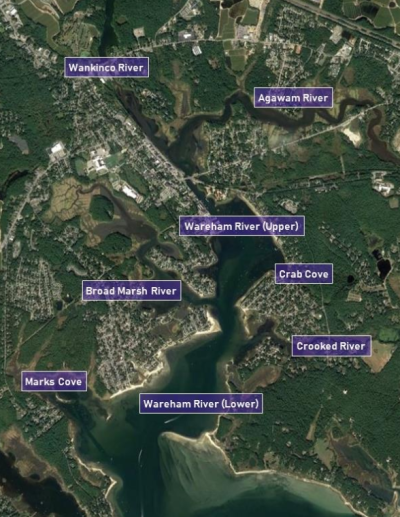State sets limits for nitrogen in Wareham River
Parts of the Wareham River will need to see a 50% reduction in nitrogen levels to protect their “clean, productive, and aesthetically pleasing marine and estuarine waters,” according to a Tuesday, June 25 report from the Massachusetts Department of Environmental Protection.
Excessive nitrogen — a chemical released from septic systems, agricultural fertilizer, wastewater treatment plants and more — has caused damage to the waters in Buzzards Bay and in Wareham.
According to the DEP, parts of the Wareham River estuary system will have to see drastic reductions in their nitrogen levels to ensure the health of their waters.
The biggest sources of nitrogen — and so the areas that will need to see the biggest cuts — include septic systems and agricultural fertilizer. The DEP recommends reducing the amount of septic load on the estuary by 79%.
The Department has specified these reductions by setting Total Maximum Daily Levels for the amount of nitrogen which can enter specific parts of the Wareham River estuary.
Upper Wareham River will need to see a 54.7% reduction in its Total Maximum Daily Levels of nitrogen, the steepest of those listed by the Department. Lower Wareham River will need to see a 34.7% reduction.
Wareham residents got the chance to participate in the process of drafting these regulations during a public hearing in November.
While the proposed limits did not change between the draft and the final version,, the Department did respond to the public’s questions, comments and concerns.
The Department responded to concerns that it used decade-old data in its report by saying that the current levels of nitrogen in the water may have changed, but the threshold levels the town needs to meet remain the same.
Residents also had concerns that the state would mandate upgrades to their septic systems. A separate process under the state’s Title 5 regulations mandated septic system upgrades in Cape Cod, and initially proposed to mandate them for Wareham as well, before the state pulled back.
There aren’t any mandates included in the Total Maximum Daily Load process, the Department said.
“The [Total Maximum Daily Load]does not require owners of septic systems to upgrade their systems within a certain number of years,” the Department wrote. “Any future proposal involving the implementation of nitrogen reducing strategies would occur only after undertaking a planning effort with the affected municipalities and after significant public process.”
For the full TMDL document, visit mass.gov/lists/total-maximum-daily-loads-by-watershed.













